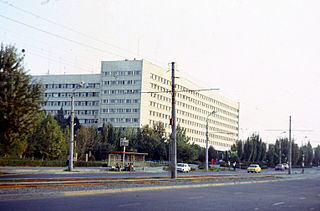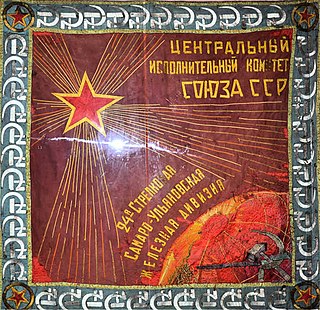
The 18th Machine Gun Artillery Division is a division of the Russian Ground Forces stationed in Sakhalin Oblast with administration over the Kuril Islands.

The Turkestan Military District was a military district of both the Imperial Russian Army and the Soviet Armed Forces, with its headquarters at Tashkent. The District was first created during the 1874 Russian military reform when by order of Minister Dmitry Milyutin the territory of Russia was divided into fourteen military districts. Its first commander was Konstantin Petrovich von Kaufmann, who was also Governor-General of Russian Turkestan at the time.
The 80th Rifle Division was a rifle division of the Red Army, formed twice.
The 99th Rifle Division was an infantry division of the Soviet Union's Red Army which fought in World War II. It was first formed in 1924, destroyed, reformed and raised to Guards status, and then reformed once again.
The 12th Rifle Division was an infantry division of the Red Army, formed twice. The division's first formation fought in the Russian Civil War and Polish–Soviet War. It was disbanded in 1921. The division formed again in 1923 at Omsk and spent World War II in Siberia. It participated in the Soviet invasion of Manchuria and was converted into a motor rifle division in 1957.

The 67th Rifle Division was an infantry division of the Red Army. The 20th Rifle Division was formed from militia brigades in the Leningrad Military District in 1923. On May 21, 1936, it was named the 67th Rifle Division. In June 1941, was part of the 27th Army in the Baltic Special Military District. After being badly battered during the early part of Operation Barbarossa, it was disbanded 19 September 1941.
The 20th Rifle Division was an infantry division of the Soviet Red Army, formed three times. The first formation of the division lasted from 1919 to 1921 and fought during the Russian Civil War before its downsizing into a brigade. The brigade became the 3rd Caucasian Rifle Division, the 3rd Caucasian Mountain Rifle Division, and the 20th Mountain Rifle Division during the interwar years. In 1944 the 20th became the 20th Rifle Division again. It was disbanded after the end of the war. The division briefly reformed between 1955 and 1957 from the 188th Rifle Division and was converted into a motor rifle division.
The 23rd Rifle Division was an infantry division of the Red Army and Soviet Army, formed three times.
The 13th Rifle Corps was a rifle corps of the Red Army, first formed in 1922.
The Turkestan Front was a front of the Red Army during the Russian Civil War, which was formed on the territory of Turkestan Military District by Order of the Republic of Turkestan on February 23, 1919. It was formed a second time by the directive of the Commander-in-Chief on August 11, 1919 on the territory of Samara, Astrakhan, Orenburg Province and Ural region by renaming the Southern group of armies from the Eastern Front of the RSFSR. Its headquarters were in Samara and by 1920 the Turkestan Front counted some 114,000 soldiers.
The 69th Rifle Division was an infantry division of the Red Army and later the Soviet Army, formed twice.

The 35th Guards Rifle Division was a division of the Soviet Red Army in World War II.
The 36th Rifle Division was a division of the Red Army and then the Soviet Army. The division was formed in 1919 as the 36th Rifle Division and fought in the Russian Civil War and the Sino-Soviet conflict of 1929. In 1937 it became the 36th Motorized Division. The division fought in the Battles of Khalkhin Gol. It was converted into a motor rifle division in 1940 and fought in the Soviet invasion of Manchuria in World War II. Postwar, it became a rifle division again before its disbandment in 1956. The division spent almost its entire service in the Soviet Far East.
The 38th Rifle Division was an infantry division of the Soviet Union's Red Army during World War II.
The 103rd Rifle Division was an infantry division of the Red Army, formed three times. It was first formed in 1939. It was converted into a motorized division and fought in the Yelnya Offensive. After being converted back to a rifle division it was destroyed in the Battle of Vyazma. The division reformed in early 1942 but was destroyed during the Second Battle of Kharkov. It was reformed a third time in the Far East in summer 1942 and participated in the Soviet invasion of Manchuria.
The 49th Rifle Division was a Soviet Army infantry division, formed three times. First formed as a territorial division in 1931, the 49th Rifle Division's first formation became a regular division by 1939 and fought in the Winter War. For its actions during the war, it was awarded the Order of the Red Banner. However, the 49th Rifle Division was wiped out during the first ten days of Operation Barbarossa. Its second formation occurred in December 1941 and fought at Stalingrad, Kursk, the Vistula-Oder Offensive and the Battle of Berlin. The second formation was disbanded in 1946. The division was reformed in 1955 by renaming the 295th Rifle Division and became the 49th Motor Rifle Division in 1957.
The 36th Guards Rifle Division was a Guards infantry division of the Red Army during World War II. It was formed from the 9th Airborne Corps in August 1942 as a result of the Soviet need for troops to fight in the Battle of Stalingrad. The division was awarded the honorific Verkhnedneprovsk for its crossing of the Dnieper in September 1943 near that town, later receiving the Order of the Red Banner and the Order of Suvorov, 2nd class, for its actions in the Uman–Botoșani Offensive in March 1944. It fought in the siege of Budapest during late 1944 and early 1945, receiving the Order of Kutuzov, 2nd class, for its actions. In late 1945, it was converted into the 24th Guards Mechanized Division. Stationed in Romania, it was disbanded in early 1947.

The 68th Mountain Rifle Division was a mountain infantry division of the Red Army before and during World War II.
The 33rd Army Corps was a corps of the Soviet Ground Forces, active from 1957 to 1991.




